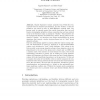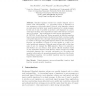284 search results - page 25 / 57 » Securing digital signatures for non-repudiation |
IMA
2005
Springer
14 years 1 months ago
2005
Springer
In recent years much research has been devoted to producing formal models of security for cryptographic primitives and to designing schemes that can be proved secure in such models...
HICSS
2002
IEEE
14 years 25 days ago
2002
IEEE
The world-wide growth of the mobile-telephony market opens the door for mobile commerce (m-commerce). For the restricted target platforms used for m-commerce such as mobile phones...
EUROCRYPT
2003
Springer
14 years 1 months ago
2003
Springer
Abstract. Digital Signatures emerge naturally from Public-Key Encryption based on trapdoor permutations, and the “duality” of the two primitives was noted as early as Diffie-He...
ASIACRYPT
2006
Springer
13 years 11 months ago
2006
Springer
Non-interactive zero-knowledge proofs play an essential role in many cryptographic protocols. We suggest several NIZK proof systems based on prime order groups with a bilinear map...
CTRSA
2007
Springer
14 years 2 months ago
2007
Springer
Standard signature schemes are usually designed only to achieve weak unforgeability – i.e. preventing forgery of signatures on new messages not previously signed. However, most s...


